As summer fades, the crisp air of autumn ushers in a season of vibrant color, rich textures, and cozy outdoor living. 🍂 While many gardeners see fall as the winding down of their growing season, the truth is that autumn presents incredible opportunities to refresh and reinvent your garden space. From fiery foliage and textured grasses to sustainable décor and wildlife-friendly features, fall garden design has its unique magic.
This guide explores the top fall garden design trends—from color choices to plant pairings and cozy garden accents that will help you transform your outdoor space into a warm, welcoming haven this season.
🍂 1. Embracing Autumn Color Palettes
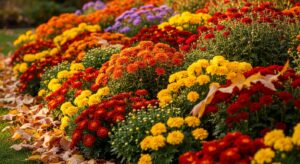
Fall’s natural color spectrum is nature’s masterpiece. To echo these harvest hues in your garden:
-
Plant mums, marigolds, zinnias, and asters in shades of red, orange, and gold.
-
Add ornamental peppers for bold reds and purples.
-
Use dusty miller or silver-leaved lamb’s ear to balance fiery tones with soft neutrals.
💡 Tip: Choose plants that bloom late into the season so your garden remains vibrant even as the temperatures drop.
🌾 2. Ornamental Grasses as Focal Points
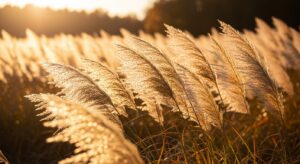
Ornamental grasses are trending because of their movement, texture, and seasonal charm. Pampas, fountain grass, and maiden grass catch the light beautifully at sunset and sway gracefully in autumn breezes.
-
Tall grasses, such as pampas, provide vertical structure.
-
Shorter varieties, such as blue fescue, add softness to borders.
-
Their seed heads also serve as natural food sources for birds.
💡 Design Idea: Place ornamental grasses near seating areas so you can enjoy their swaying beauty up close.
🎃 3. Decorative Gourds and Pumpkins
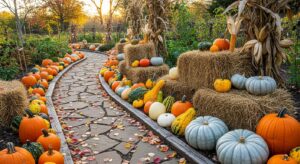
Nothing says “fall” quite like pumpkins. Beyond carving, they’ve become an essential design feature in gardens.
-
Arrange clusters of pumpkins and gourds along walkways.
-
Use white or pastel pumpkins for a chic, modern vibe.
-
Pair pumpkins with hay bales or corn stalks for a rustic harvest look.
💡 Tip: Mix sizes and colors to create layers of interest, think tiny gourds with large pumpkins.
🪴 4. Fall Container Gardens
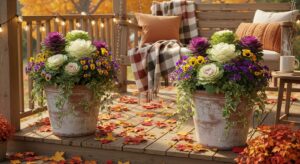
Containers are one of the easiest ways to add fall flair to patios, porches, or entryways.
-
Combine ornamental kale, pansies, ivy, and chrysanthemums.
-
Use rustic planters like whiskey barrels or galvanized tubs for seasonal charm.
-
Add trailing plants like creeping Jenny for cascading color.
💡 Idea: Mix edible herbs like thyme and sage with flowers for a container that’s both practical and beautiful.
🕯 5. Cozy Outdoor Living Spaces
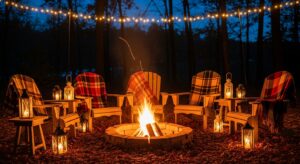
As temperatures cool, people crave outdoor spaces that feel warm and inviting.
-
Add string lights, lanterns, and candles for soft illumination.
-
Create a fire pit area with Adirondack chairs and plaid throws.
-
Add weatherproof cushions in warm harvest tones like mustard, burgundy, and deep green.
💡 Tip: Choose solar-powered lights for an eco-friendly glow.
🌹 6. Late-Blooming Perennials
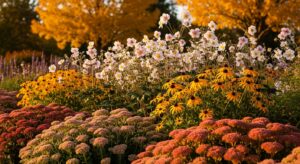
Keep your garden alive well into fall with perennials that thrive in cooler weather.
-
Japanese anemones offer delicate pink or white blooms.
-
Black-eyed Susans bring cheerful yellow hues.
-
Sedum ‘Autumn Joy’ shifts from pink to deep burgundy as the season progresses.
💡 Tip: Plant them in mixed borders to extend color variety late into the season.
🌳 7. Incorporating Fall Trees and Shrubs
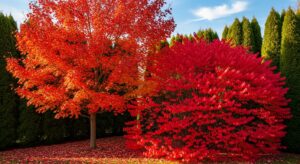
Fall trees and shrubs create the dramatic backdrops every autumn garden needs.
-
Maples bring fiery reds and oranges.
-
Dogwoods add deep burgundy foliage and striking berries.
-
Burning bush shrubs live up to their name with glowing red leaves.
💡 Tip: Combine deciduous trees with evergreens to maintain color and structure all year.
🪵 8. Natural Garden Accents

Rustic décor has never been more stylish.
-
Add wooden benches or swings for charm and functionality.
-
Use reclaimed barrels or crates as planters.
-
Incorporate stone borders or pathways to tie the garden together.
💡 Design Idea: Straw bales and corn stalk bundles make seasonal, biodegradable decorations.
🕊 9. Wildlife-Friendly Gardens
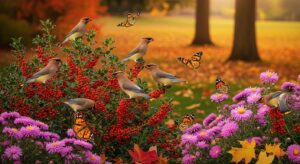
Creating a fall garden that supports wildlife makes your space both beautiful and purposeful.
-
Plant berry-producing shrubs like viburnum and holly for birds.
-
Add asters and goldenrod to support pollinators.
-
Leave some seed heads standing through winter for food and shelter.
💡 Tip: Add a birdbath or small water feature to keep wildlife visiting.
🌟 10. Layered Planting for Depth
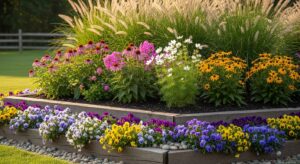
A garden designed in layers always feels lush and dynamic.
-
Place tall grasses or shrubs at the back, mid-height perennials in the center, and groundcovers in front.
-
Add pops of annuals for instant color.
-
Incorporate foliage with different textures—spiky, feathery, and smooth—for contrast.
💡 Tip: Layered planting also helps extend bloom time by mixing early, mid, and late-season plants.
🥕 11. Edible Fall Gardens
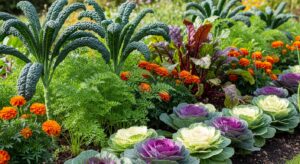
Blending function and beauty is a trend that continues to rise.
-
Plant fall vegetables like kale, beets, carrots, and spinach.
-
Interplant veggies with flowers to create a decorative edible landscape.
-
Use raised beds or vertical planters for a modern, structured look.
💡 Idea: Pair deep purple kale with golden marigolds for a stunning edible design.
🌿 12. Sustainable & Eco-Friendly Touches
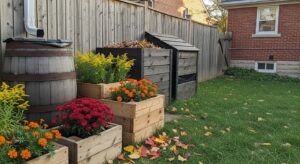
Sustainability isn’t just trendy, it’s essential.
-
Compost leaves to recycle nutrients.
-
Use mulch to protect plants and conserve soil moisture.
-
Add rain barrels to collect water for irrigation.
-
Repurpose natural materials like logs or reclaimed wood for borders and garden furniture.
💡 Tip: Sustainable design adds character while reducing your ecological footprint.
🍂 Final Thoughts
Autumn is a season of transformation, and your garden can reflect that beauty with thoughtful design choices. From harvest hues of fiery foliage to cozy seating areas and wildlife-friendly plantings, these trends celebrate the season’s richness while extending your enjoyment outdoors.
With the right touches, your fall garden becomes more than just a space; it’s an experience of warmth, color, and connection with nature. 🌻✨
❓ FAQs: Harvest Hues – Fall Garden Design Trends
🍁 1. What colors work best for a fall garden design?
The best fall gardens showcase warm, earthy tones like orange, red, yellow, and burgundy. Complement them with deep greens, purples, and neutral silvers (like dusty miller) for balance.
🌾 2. Which plants provide the most color in autumn?
Popular fall bloomers include chrysanthemums, asters, sedum, black-eyed Susans, and ornamental kale. Trees like maples and shrubs such as burning bush also add bold seasonal color.
🎃 3. How can I decorate my garden with pumpkins without it looking too “Halloween”?
Choose a mix of neutral-toned pumpkins like white, green, or pastel varieties. Pair them with gourds, ornamental grasses, and rustic containers to create an elegant fall display.
🪴 4. What are good plants for fall container gardens?
Fall container favorites include mums, pansies, ornamental kale, creeping Jenny, and ivy. Mix trailing, upright, and filler plants for a layered and balanced look.
🕯 5. How can I make my garden cozy for fall evenings?
Add string lights, lanterns, fire pits, and soft throws to create a warm, welcoming space. Choosing deep-toned outdoor cushions also enhances the autumn vibe.
🌹 6. Are there flowers that bloom all the way through fall?
Yes! Japanese anemones, chrysanthemums, asters, and sedum ‘Autumn Joy’ bloom well into late fall, keeping your garden colorful until frost.
🕊 7. How do I attract wildlife to my fall garden?
Plant berry-producing shrubs, leave seed heads, and add late-blooming flowers like goldenrod and asters. A birdbath or water feature also encourages wildlife visits.
🌳 8. What trees give the best fall foliage?
Maples, dogwoods, birches, and liquidambar trees are all known for their fiery foliage. Pair them with evergreens for lasting structure.
🥕 9. Can I grow vegetables in a fall garden?
Absolutely! Many vegetables thrive in cooler weather, such as kale, beets, carrots, spinach, and radishes. Pair them with flowers for a beautiful edible garden.
🌿 10. What are some eco-friendly ways to design my fall garden?
Use composted leaves, natural mulch, reclaimed wood, and rain barrels for sustainable gardening. Plant native species to support local ecosystems.